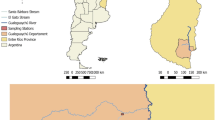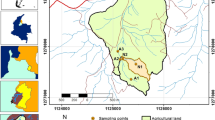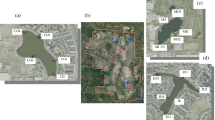Abstract
Environmental problems many times could evolve when manure-containing pathogens are distributed into an open environment with no effort made to reduce the content of pathogens or limit their movement in the environment. Wind, surface flow, and subsurface flow can all carry enough pathogens to receiving waters to exceed water quality standards. This study was conducted to assess the microbiological quality of water associated with animal-based agriculture in the sub-basin of Pinhal River located in the rural area of Concordia, Santa Catarina, Brazil. Six sampling points representing different agricultural land uses (LU1—dairy cattle; LU2—without animals; LU3—dairy + pigs + poultry + crops; LU4—pigs + poultry + crops; LU5—dairy + pigs + poultry + crops + human; and LU6—dairy+pigs+crops) along the Pinhal River sub-basin (north to south) were sampled biweekly from August 2006 to December 2008. Concentrations of fecal coliforms and Escherichia coli varied significantly (p ≤ 0.05) with land use (LU), but there was no interaction effect of LU, season, and time. Water samples from the catchment area of LU1 had the highest concentration of fecal coliforms (4,479 ± 597 CFU ml−1) when compared with other catchment areas. Catchment area associated with LU2 (no animal) had the lowest concentrations of fecal coliforms (39.2 ± 5.2 CFU ml−1). With the exception of LU2 (control site), all the maximum concentrations of E. coli exceeded the single maximum allowable concentration for E. coli (100 CFU ml−1). When LU1 was compared with other catchment areas (LU3, 50%; LU4, 67%; LU5, 58%; and LU6, 44%), it had the lowest counts (39%) of Salmonella sp. Our results suggest that spatial pattern of bacterial water quality is evident, which can be linked to the different land uses and associated practices (present or absent of animal activities). Therefore, varying responses associated with the different land uses would be critical in identifying the importance of different sources of bacteria in the catchment area and the mechanisms transferring them.


Similar content being viewed by others
References
Abu-Shour, J., Joy, D. M., Lee, H., Whiteley, R., & Zelin, S. (1994). Transport of microorganisms through soil. Water, Air, and Soil Pollution, 75, 141–158.
American Public Health Association. (1992) Standard methods for the examination of water and wastewater, 18th ed. APHA, Washington.
Cote, C., Villeneuve, A., Lessard, L., & Quessy, S. (2006). Fate of pathogenic and nonpathogenic microorganisms during storage of liquid hog manure in Quebec. Livestock Science, 102, 204–210.
Crowther, J., Kay, D., & Wyer, M. D. (2002). Faecal-indicator concentrations in waters draining lowland pastoral catchments in the UK: Relationship with land use and farming practices. Water Research, 36, 1725–1734.
Culley, J. L. B., & Philips, P. A. (1982). Bacteriological quality of surface and subsurface runoff from manured sandy clay loam soil. Journal of Environmental Quality, 11, 155–158.
Doran, J. W., & Linn, D. M. (1979). Bacteriological quality of runoff water from pastureland. Applied and Environmental Microbiology, 37(5), 985–991.
Edwards, D. R., Coyne, M. S., Vendrell, P. F., Daniel, T. C., Moore, P. A., & Murdoch, J. F. (1997). Fecal coliform and streptococcus concentrations in runoff from grazed pastures in northwest Arkansas. Journal of the American Water Resources Association, 33(2), 413–422.
Gary, H. L., Jhonson, S. R., & Ponce, S. L. (1983). Cattle grazing impact on surface water quality in a Colorado front range. Journal of Soil and Water Conservation, 38, 124–128.
Hutchison, M. L., Walters, L. D., Avery, S. M., Munro, F., & Moore, A. (2005). Analyses of livestock production, waste storage, and pathogen levels and prevalence in farm manures. Applied and Environmental Microbiology, 71, 1231–1236.
Hunter, C., Perkins, J., Tranter, J., & Gunn, J. (1999). Agricultural land-use effects on the indicator bacterial quality of an upland stream in the Derbyshire peak district in the U.K. Water Research, 33(17), 3577–3586.
Jamieson, R., Gordon, R., Joy, D., & Lee, H. (2004). Assessing microbial pollution of rural surface waters: a review of current watershed scale modeling approaches. Agricultural Water Management, 70, 1–17.
Janzen, J. J., Bodine, A. B., & Luszez, L. J. (1975). A survey of effects of animal wastes on stream pollution from selected dairy farms. Journal of Dairy Science, 57, 260–263.
Jones, D. L. (1999). Potential health risks associated with the persistence of Escherichia coli in agricultural environment. Soil Use and Management, 15, 76–83.
Kay, D., Crowther, J., Fewtrell, L., Francis, C. A., Hopkins, M., Kay, C., et al. (2008). Quantification and control of microbial pollution from agriculture: A new policy challenge? Environmental Science and Policy, 11, 171–184.
Khaleel, R., Reddy, K. R., & Overcash, M. R. (1980). Transport of potential pollutants in runoff water from land areas receiving animal wastes: A review. Water Research, 14, 421–436.
Mawdsley, J. L., Bardgett, R. D., Merry, R. J., Pain, B. F., & Thedorou, M. K. (1995). Pathogens in livestock waste, their potential for movement through soil and environmental pollution. Applied Soil Ecology, 2, 1–15.
Michael, G. B., Simoneti, R., Costa, M., & Cardoso, M. (2003). Comparison of different selective enrichment steps to isolate Salmonella sp. from feces of finishing swine. Brazilian Journal of Microbiology, 34, 138–142.
Oliver, D. M., Heathwaite, L., Haygarth, P. M., & Clegg, C. D. (2005). Transfer of Escherichia coli to water from drained and undrained grassland after grazing. Journal of Environmental Quality, 34, 918–925.
Patni, N. K., Toxopeus, R., Tennant, A. D., & Hore, F. R. (1984). Bacterial quality of tile drainage water from manured and fertilized cropland. Water Research, 18, 127–132.
Pell, A. N. (1997). Manure and microbes: Public and animal health problem. Journal of Dairy Science, 80, 2673–2681.
Quinn, P. J., Carter, M. E., Markey, B. K., & Carter, G. R. (1994). Clinical veterinary microbiology (p. 648). London: Wolfe. ISBN 0 7234 1711 3.
Rodgers, P., Soulsby, C., Hunter, C., & Petry, J. (2003). Spatial and temporal bacterial quality of a lowland agricultural stream in northeast Scotland. Science of the Total Environment, 314, 289–302.
SAS Institute. (2000). SAS/STAT user’s guide. Release 6.03 (p. 494). Cary: SAS Institute.
Shigaki, F., Sharpley, A., & Prochnow, L. I. (2006). Animal-based agriculture, phosphorus management and water quality in Brazil: Options for the future. Science in Agriculture, 63(2), 194–209.
Sigua, G. C., & Coleman, S. W. (2007). Sustainable management of nutrients in forage-based pasture soils: Effect of animal congregation sites. Journal of Soils and Sediments, 6(4), 249–253.
Sigua, G. C., Williams, M. J., Coleman, S. W., & Starks, R. (2006). Nitrogen and phosphorus status of soils and trophic state of lakes associated with forage-based beef cattle operations in Florida. Journal of Environmental Quality, 35, 240–252.
Smith, M. S., Thomas, G. W., White, R. E., & Ritonga, D. (1985). Transport of Escherichia coli through intact and disturbed soil columns. Journal of Environmental Quality, 14, 87–91.
Tong, S. T., & Chen, W. (2002). Modeling the relationship between land use and surface water quality. Journal of Environmental Management, 66, 377–393.
Tyrrel, S. F., & Quinton, J. N. (2003). Overland flow transport of pathogens from agricultural land receiving fecal wastes. Journal of Applied Microbiology, 94, 87–93.
Author information
Authors and Affiliations
Corresponding author
Rights and permissions
About this article
Cite this article
Sigua, G.C., Palhares, J.C.P., Kich, J.D. et al. Microbiological Quality Assessment of Watershed Associated with Animal-Based Agriculture in Santa Catarina, Brazil. Water Air Soil Pollut 210, 307–316 (2010). https://doi.org/10.1007/s11270-009-0254-y
Received:
Accepted:
Published:
Issue Date:
DOI: https://doi.org/10.1007/s11270-009-0254-y




